The video experts blog
Live Audio Streaming: How to Broadcast Audio with a Professional Platform [2023 Update]
Live audio streaming is incredibly popular. Podcasts in particular have been a hit, with an unprecedented 464.7 million people listening to podcasts daily worldwide. This number is epxected to reach 504.9 million by 2024. Moreover, the podcast industry market size is currently an immense $23.56 million. The music streaming industry, too, has experienced massive growth with millions of audio files being downloaded every day.
Suffice it to say, savvy businesses, entrepreneurs and organizations of all kind have taken the reins on this trend, and many are reaping the rewards. Both businesses and aspiring individuals are keen to learn how best to set up and stream live audio so they can get their message out.
In this article, we’ll cover how to stream live audio and how to choose the right live video solution for streaming audio. We’ll discuss why a professional live video streaming solution is ideal for hosting and streaming audio files. Furthermore, we’ll compare the top 10 live audio streaming platforms available today.
The Rise of Podcasting and Online Radio
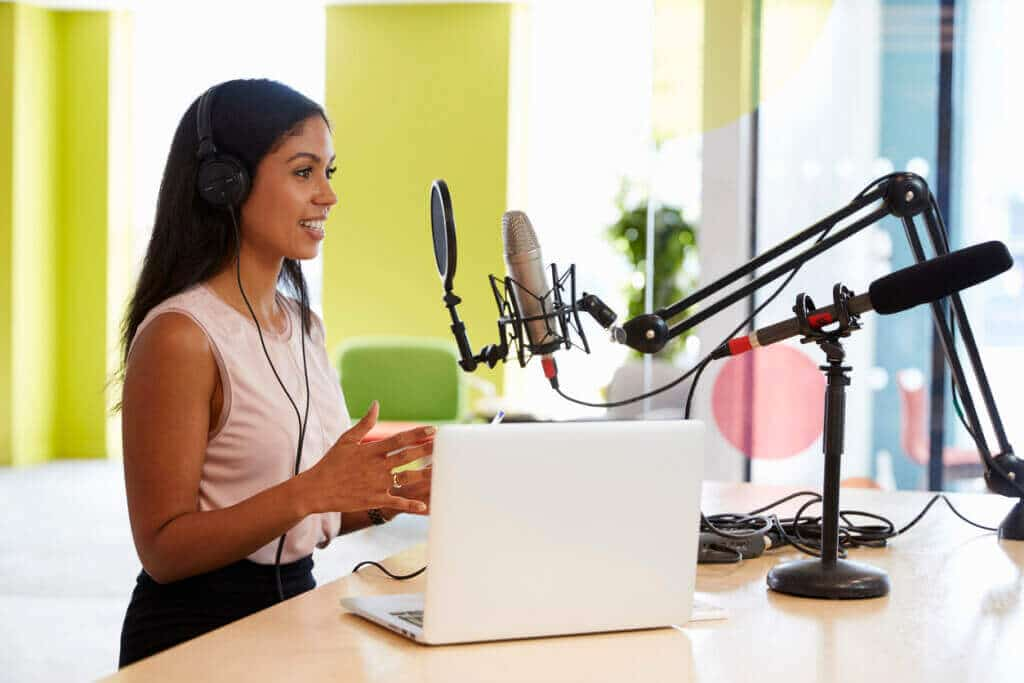

Audio-only streaming is on the rise.
Nearly 90% of people from around the world tune into audio-only streams on the regular. Given that massive audience size, it’s no surprise that we’re witnessing a renaissance in broadcasting live audio.
All kinds of businesses, organizations, individuals, and even the music industry are broadcasting live audio. Here are a few examples of genres and industries that are taking advantage of this renaissance:
- Full-fledged radio stations with diverse programming
- News and media outlets
- Traditional music-based radio shows
- Talk shows
- Comedy
- Educational podcasts or radio channels
- Business and entrepreneurial podcasts and recordings
- Sports broadcasts
- Religious broadcasts
- Entertainment and audio drama
The appeal to audio-only streaming is that it consumes significantly less bandwidth than video streaming. It is also quite convenient for listeners to tune into an audio-only stream. Listeners can play audio while they drive, work out, or do other daily activities without posing too much distraction.
The growing popularity of audio streaming gives most businesses and organizations the incentive to hop on the trend and reach their audience in a new way.
Apple music, YouTube music, Amazon music unlimited and other music streaming services are benefiting from the popularity. By providing professional streaming music services across the globe to meet their high demand, these companies and others are reaping the financial rewards.
How to Stream Live Audio Like a Professional
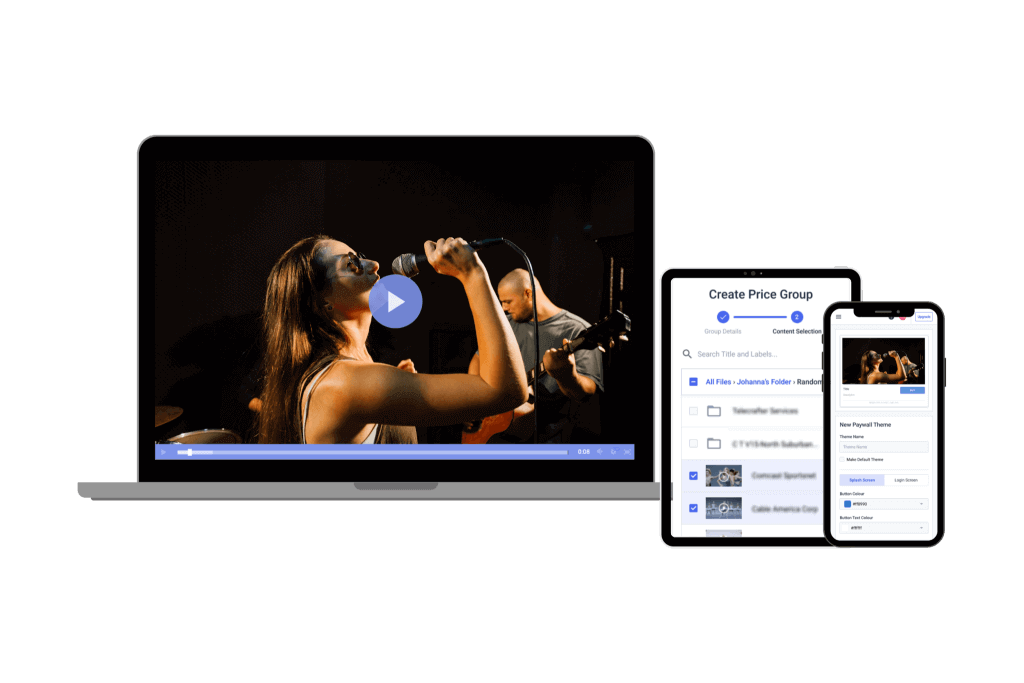

Streaming live audio is easier than ever with the right online streaming platform.
Jumping on the trend and learning how to broadcast a podcast live (or how to host your own radio show online) is simple. Learning how to broadcast a podcast is generally easier than learning how to stream audio and video because you don’t have to worry so much about a quality picture and other visual aspects.
With that said, let’s take a look at how to livestream audio only.
1. Make a Plan
Every good audio stream starts with a solid video streaming strategy. You don’t have to have every moment scripted, but having an outline of the segments you want to cover will come in handy.
Aside from planning individual episodes, you’ll need a master plan of sorts. Create a document that outlines the purpose of your audio show, who you’re trying to reach, and what you’re trying to achieve. Plot out how you will bring those goals to life.
Make specific notes of which features you’ll need to be successful. For example, if you plan on generating revenue from your stream, video monetization tools are a must.
2. Choose a Live Audio Streaming Platform
Once you know what features you’re looking for, it is time to choose a live audio streaming platform. Many professional video hosting platforms have audio-only capabilities. The value of hosting your stream on a professional platform like this is that you have access to scalable tools.
Further on in this post, we will provide an in-depth comparison of 10 of the top live streaming platforms to help you make a smart choice.
3. Embed Your Audio Player into Your Website
Another key element is embedding your live stream in the correct location. Most online radio stations embed a player right at the top of their website. You can also embed on the websites of partners/advertisers, individual shows, DJ/host blogs, and so on.
The process of embedding a live feed using Dacast is easy. To do so, log in to your account. In your list of live channels, click on the radio channel you want to embed. Remember that you can have multiple simultaneous channels, so choose the right one.
On the next page, click the “Publish Settings” tab. The lower-left section of this publish settings page will provide several different embed codes for you to choose between. There are two main options: iframe and JS (Javascript). We recommend using the JS embed code, especially if you want to use the full-screen option.
For quick sharing among your network, you also have a “share code” which is a simple URL where your followers can directly access your podcast.
4. Get Your Podcast Listed


You can list your podcast on a few different platforms to extend your reach.
If you’re hosting a podcast using Dacast or another live video streaming solution, it’s easy to get listed on iTunes, Stitcher, and other podcasting services. Before listing, make sure your podcast supports the following specifications:
- Feed available via the RSS 2.0 specification
- The feed contains artwork between 1400 x 1400 and 3000 x 3000 pixels, 72dpi, JPEG or PNG format, and RGB colorspace
- Proper metadata for each episode
- More best practices here
Then, you can go ahead and submit your podcast via iTunes podcast connect. The process is similar for listing on Stitcher and YouTube Music.
5. Create Your Setup
Now, it is time to get your microphone set up with your streaming software. All you need is a quality microphone that can be connected to a computer. Most broadcasters use USB mics or XLR mics connected via some sort of soundboard. Once this is set up, you can pull that audio feed into a live broadcasting software application.
Once this is done, you can connect your software to your online video platform. This involves entering the streaming information of your video content (provided by your live streaming solution) and enter your encoder settings
Many podcasters and radio show hosts create a sound-proof area with good acoustics to record their live audio streams. Luckily, capturing audio is much simpler than video since you don’t have to worry about lighting or the general aesthetic.
You can create your audio setup in a relatively small space since you don’t have to consider the appearance of the background.
6. Test Your Setup
One essential step to live audio streaming is testing your streaming setup to identify any snags in the system. This is really important because when you’re streaming live, there is no room to correct mistakes in real-time.
We recommend running a couple of tests to make sure you’re good to go.
7. Start Streaming
Once you’ve confirmed that your streaming equipment and setup are working properly, it is time to start streaming. Learning how to make a podcast live on most live audio streaming platforms is super simple. It’s often just a matter of clicking “Start Stream.”
Remember to remain confident while having a little fun with your live audio stream. Even though not a single person in the audience can see you, they will get a sense of your attitude and mood through the sound of your voice.
Top 10 Live Audio Streaming Platforms
Now that you know how to broadcast a podcast live, let’s talk about specific platforms to choose from. As mentioned, the best way to live stream a podcast is to choose a reliable audio streaming platform to host your audio-only content.
Fortunately, many video streaming companies offer robust live audio streaming because many of the features required for a quality video stream are similar to what’s required for online audio streams meaning you get core audio broadcast features plus more. For example, two of many features that’s very advanced among video platforms that support live streaming audio are analytics and security.
With that said, we’ve rounded up 10 of the best audio live streaming platforms. Most of the platforms on our list offer extensive documentation on how to livestream audio only using their platform.
Let’s take a close look at the features and pricing of each of the live audio streaming software on our list.
1. Dacast
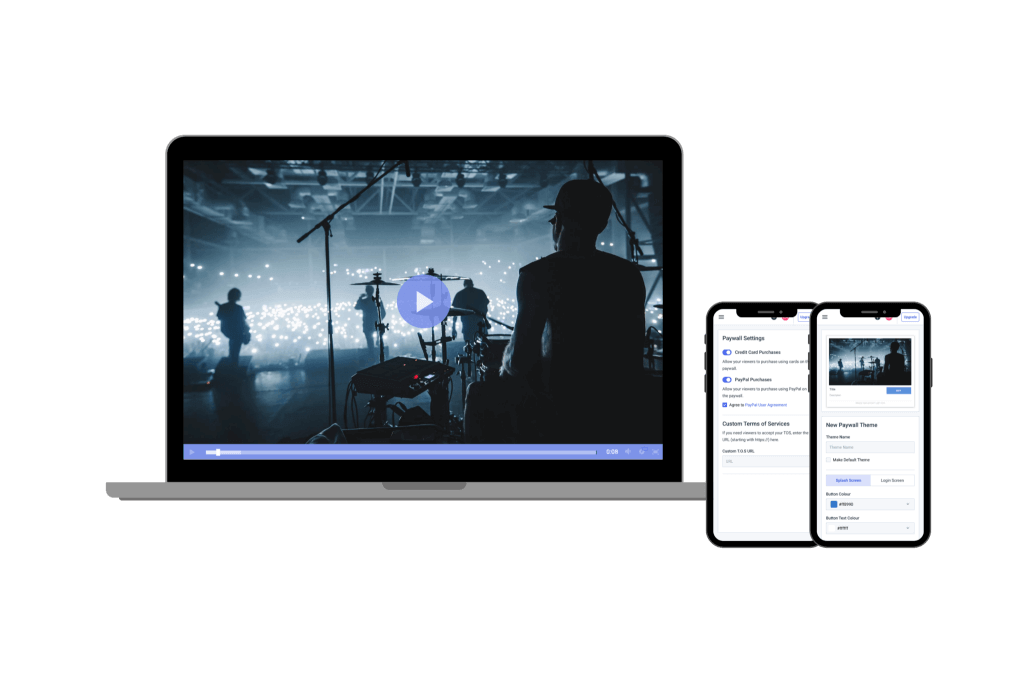

Dacast is the preferred live audio streaming platform among many professional broadcasters.
Dacast is a highly capable professional tool that supports audio-only streaming. This platform is so appealing because it is fully loaded with the professional tools that an audio broadcaster needs.
Dacast is equipped with a white-label video player that can be customized to meet your needs and embedded in just about any website or app. Also, unlike many podcast hosting services, Dacast allows you to broadcast live instead of only posting pre-recorded audios.
Another appealing aspect of Dacast is that the streaming software is available at a variety of different price points. And even on the cheapest plan, you get access to 500 GB of storage. To put matters in context, most podcast hosting services only give you about 1 GB or even as low as 100 MB. So if you’re really serious about 1 GB or even as low as 100 MB. So if you’re really serious about posting many podcasts with high-quality sound and the potential to go viral, it’s worth investing in storage from the get-go.
Key Features:
- Embed players on the streaming website of your choice
- Stream recorded live video, music, and podcasts
- Broadcast audio 24/7
- Ability to schedule audio events
- Broadcast multiple radio stations from the same account simultaneously
- Stream to multiple sources at once
- Fast, global delivery via top-tier live streaming CDNs
- Access detailed user and video analytics
- HTML5 player
- Secure content with geographic and IP restrictions
- Password-protected live event streaming
- Streaming API with RESTful API access for both video and player API.
- Multi-user access on Scale and Custom plans
- Zoom live streaming integration for meetings and live events in real-time
New!
- Streaming API with RESTful API access for both video and player API
- Expo 2.0 galleries video portal for immersive video experiences
- Multi-user access on Scale and Custom plans
- Zoom live streaming integration for meetings and live events in real-time
Pros:
- Access to a wide variety of professional streaming features
- Reliable content delivery
- Built-in paywall if you want to monetize through subscriptions or pay-per-stream
- Encoded using AAC codec meaning high-quality audio
- Pricing plans for every streaming budget
- Broadcast live shows, not just pre-recorded content
- Audio analytics, like average listening time, so you can measure and improve.
- 24/7 audio support
- 14-day free trial
Cons:
- May require a bit of a learning curve
Pricing:
Streaming platform pricing plans with Dacast start at $39 per month and include four levels:
- Starter plan – $39 per month billed annually. Ideal for newcomers with 2.4 TB of bandwidth and 500 GB of storage per year.
- Scale plan – $250 per month or $165 per month when billed annually. Includes 24 TB of bandwidth per year, with 2 TB of storage. The Scale pricing plan adds phone support, monetization paywall, an M3U8 online player for live channels, ad insertion, white-label player, advanced analytics, and video API access. Additional bandwidth (overage protection) is available as an optional feature. Read more here about Dacast’s live streaming pricing plans.
- Event plan – $63 per month billed annually. Geared towards organizations that would rather not sign a contract, and want to purchase bandwidth separately to live stream an event. It offers 6 TB of bandwidth upfront, 250 GB of storage. Additional data and storage can be added as needed.
Custom plan: If your enterprise business has high-volume streaming needs, you can contact Dacast for a custom plan tailored to your needs.
2. Cincopa
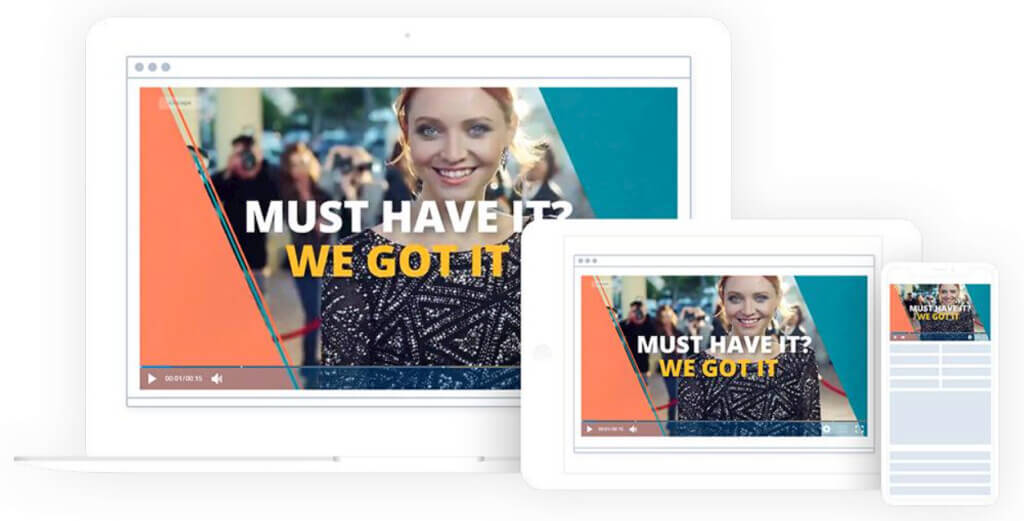

Cincopa is a dedicated multimedia hosting platform.
Cincopa is a multimedia hosting platform that is capable of storing video files, audio files, photos, and more. This platform is a bit different than the other platforms that we will compare in this post since it has dedicated audio hosting support.
Key Features:
- Tools or businesses with large multimedia storage/hosting needs
- HTML5 audio player
- More than 25 HTML5 audio player templates
- Podcast galleries that allow you to list your episodes in an organized format (for example, by seasons.)
- Solutions for sales, marketing, education, production, publishing, and more
- Monetization tools
- Analytics
Pros
- Dedicated support for audio streaming
- Plans at every price point
- Access to specialized features for a variety of use cases
- Allow listeners to download your podcast from your site
- 30-day trial
Cons:
- A large number of features makes the platform a bit complicated
Pricing:
Cincopa offers four distinct pricing plans:
- Startup: $9/month; designed for a team of 1; limited hosting tools
- Plus: $25/month; includes marketing tools (CTAs, email integrations, etc.)
- Corporate: $99/month; advanced broadcasting tools
- Agency/Enterprise: $350/month; advanced broadcasting tools with more flexibility
Please check out Cincopa’s pricing page for a further breakdown of storage and capabilities that come with each plan.
3. Kaltura
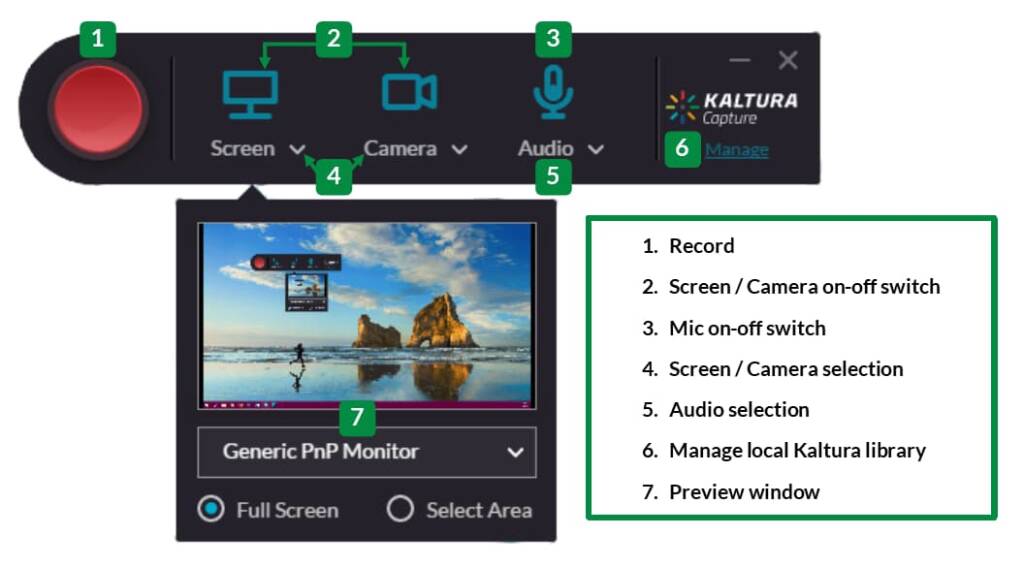

Kaltura is best suited for streamers that need customization capabilities.
Kaltura is a highly customizable audio streaming solution that is open source. Users can integrate a wide variety of settings to create the audio broadcasting experience that they are looking for.
Kaltura’s customizable nature makes it a great option for audio broadcasters that have unique needs or are after a very particular end result.
Key Features:
- A highly customizable audio streaming experience
- Multi-bitrate and adaptive streaming are included
- Reliable content delivery via a combined CDN approach
- Ability to bring your own CDN)
- Tech support via a ticket-based system, which is slower than chat or phone
- Interactive podcasts with quizzes
- Security features, including a range of authentication and encryption options
- Monetization, including all major models (subscription, advertising, etc.)
Pros:
- Many audio streaming specific features available
- Reliable delivery
- Multiple monetization options
- Mobile apps available for iOS and Android
- Ability to edit podcasts straight from the app
- Offline listening available
- No phone or chat support
Pricing:
Kaltura uses a credit-based pricing system. Broadcasters can purchase credits to spend on bandwidth and access to additional features and integrations.
4. Muvi
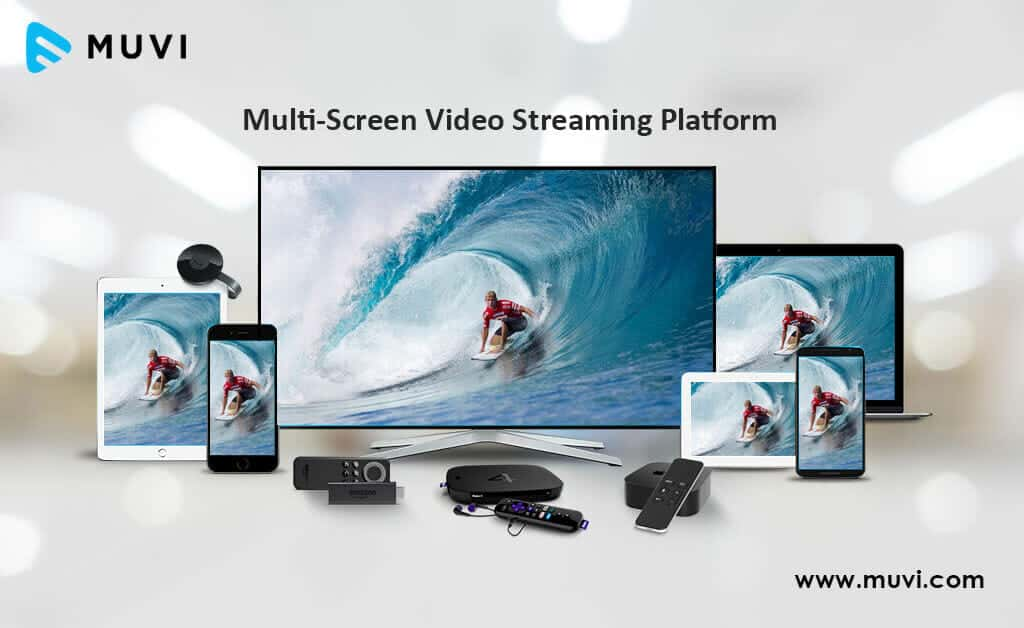

Muvi is an OTT-focused live audio streaming solution.
Muvi helps broadcasters set up OTT streaming platforms for both video and audio content. It is equipped with tools for brand control, customization, monetization, and more.
Muvi offers 500+ podcast features, which is great for users who have the time and expertise to learn and understand the platform. However, it can get a bit overwhelming for new audio broadcasters.
Key Features:
- Live and on-demand hosting
- Custom branding
- HTML5 video player
- DRM and security features
- White-label audio player with branding customization
- Real-time podcast analytics
- Monetization tools
- DVR-enabled livestream for listeners to pause and rewind live audio.
Pros:
- End-to-end podcast hosting
- Reliable content delivery through powerful CDN
- Transcoding support for high-quality streaming
- Live stream podcasts
- Online store for you to sell brand merchandise
Cons:
- The platform is not user friendly
- Difficulty with integrations
- CMS user interface is complex
- Does not support China delivery
Pricing:
Muvi has four different pricing plans:
- Standard: $399/month (+ $299/month per app + infra fees), allows 2,000 concurrent listeners, 1 TB of bandwidth, 1 TB of storage, 200 GB of encoding, and API access.
- Professional: $1,499 per month (+ $499/month per app + infra fees), increases limits to 10,000 concurrent users, 2 TB of bandwidth, 2 TB of storage, 500 GB of encoding, and adds premium support.
- Enterprise: $3,900 per month (+ $499/month per app + infra fees), allows 50,000 concurrent listeners, 5 TB of bandwidth, 5 TB of storage, 1 TB of encoding, and adds a dedicated server, Enterprise support, and the ability to use your own CDN.
- Ultimate: A custom solution that includes everything in the Enterprise plan with limits extended to unlimited users, 10 TB of bandwidth, 10 TB of storage, 2 TB of encoding, plus a dedicated hosting server with auto scaling as well as monthly security and performance reports.
5. Livestream
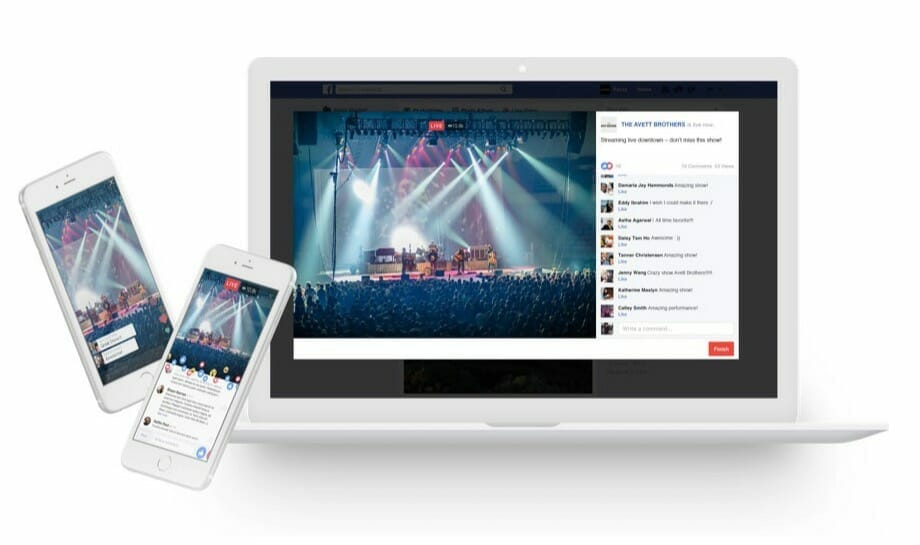

Livestream is a premier streaming solution for live audio.
Vimeo is a premium streaming service that caters to a wide range of audiences, including creative professionals and businesses. It requires that every stream uses a video feed, but there are multiple loopholes for users to host an audio-only stream.
The main appeal to this platform is that it supports unlimited listeners. That means you can have as many people tune into your live audio stream as you’d like without any friction from Vimeo (formerly Livestream).
Key Features:
- High-quality audio streaming
- Large storage capacity
- Privacy options
- Upload from anywhere
Pros:
- Ad-free streaming
- Sleek and professional appearance
- Thoroughly detailed analytics
- Easy to use platform
- Monetization option
Cons:
- High price point
- No China video delivery
- It’s more video-oriented and although there are loopholes for audio only, it’s not their main focus.
- You may be paying for many features you don’t need if you only use it for audio
Pricing:
These are Vimeo’s live streaming pricing & plans:
Advanced:
- Advanced pricing: $65/month per seat, billed annually
- The Advanced plan includes both live streaming and VOD support. This plan is the best option for professional broadcasting on this platform.
Enterprise:
- Enterprise pricing: Please contact Vimeo for custom pricing information
- The Enterprise plan includes everything in Advanced, plus multiple simultaneous streams, advanced marketing integrations, and video API access. It also includes dedicated support and enhanced security and privacy features.
- Vimeo OTT pricing: Contact Vimeo for custom pricing information
- The Vimeo OTT plan comes with Starter, Growth, and Enterprise OTT, free web app, seamless monetization options, dedicated support, and account management. These plans include all the basics for starting your web-based OTT channel, as well as growing your OTT streaming business online.
6. Brightcove
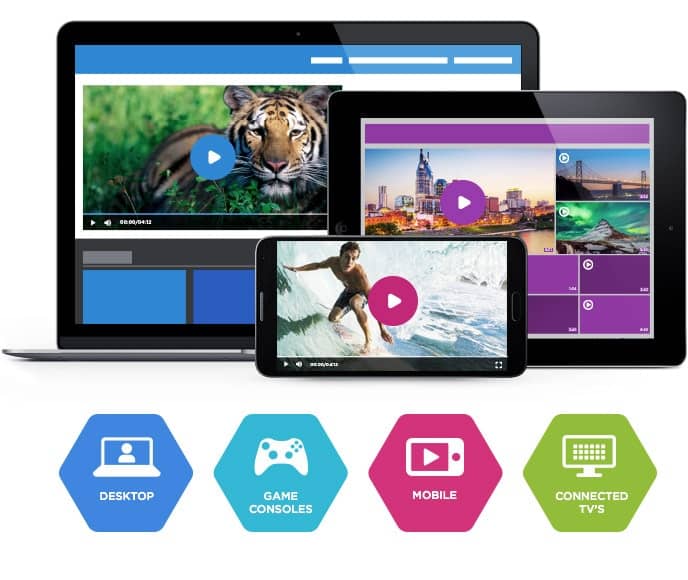

Brightcove is another top-tier, professional-grade streaming solution renowned for its exceptional prowess in audio streaming. It has many notable features, including video monetization, API access, and more.
All of Brightcove’s plans are custom-priced. However, past users report plans starting at $500/month. This places Brightcove in the upper echelons of luxury platforms, tailor-made for advanced broadcasting. It also makes Brightcove the preferred choice for those seeking high-quality, professional audio streaming solutions.
Key Features:
- Multi-bitrate and adaptive streaming
- Global content delivery
- Tech support
- Video API access
- Security features
Pros:
- Insightful analytics to track performance
- Ability to create an audio player with or without image
- Extensive documentation for audio player
- CRM integration
- Privacy and security settings
- Editing tools
- Permissions configuration
- Easy-to-use interface
Cons:
- Very expensive (not well-suited for beginners)
- If you’re using for audio-only purposes, you may be paying too much
- No China video delivery
Pricing:
Mainly targeting huge clients, Brightcove doesn’t provide pricing information. Interested broadcasters can contact their sales department to receive a quote or request a demo.
7. Vidyard
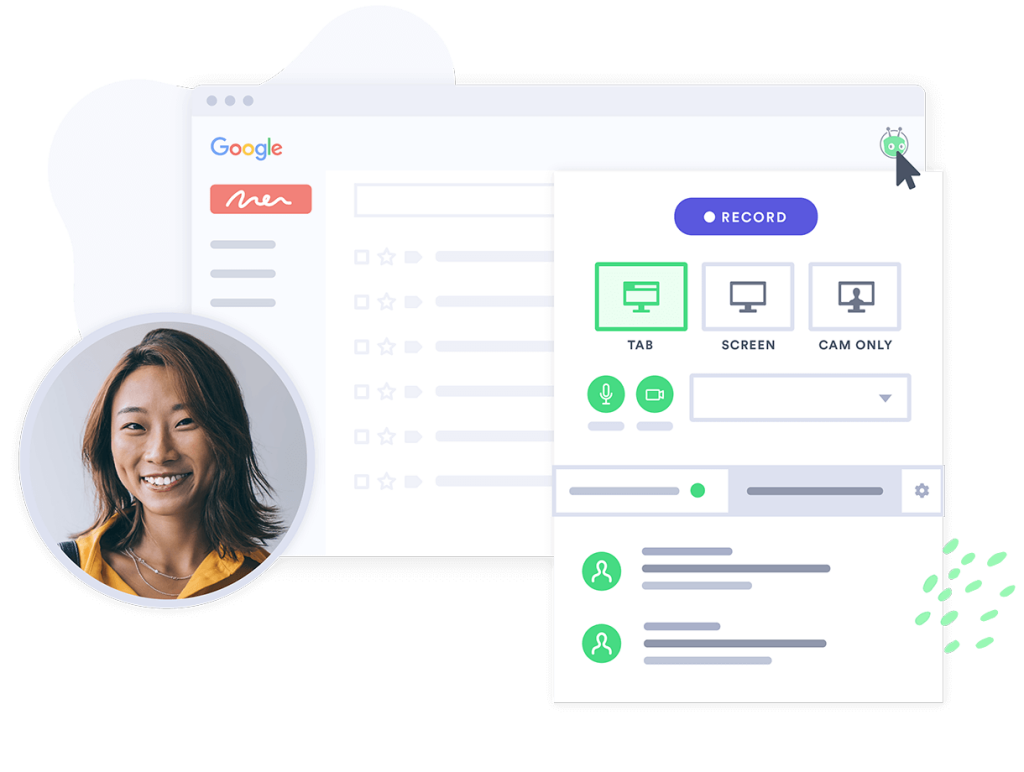

Vidyard is a professional video and audio streaming platform that offers a range of pricing packages to suit different budgets. With a basic Free plan, along with Pro, Plus, and Business plans, Vidyard offers accessible pricing for users seeking scalability in their audio streaming endeavors.
Beyond its cost-effectiveness, Vidyard provides extensive support for various tools and functionalities. This makes it an excellent choice for those looking to engage in professional-grade audio streaming while managing their budget effectively.
Key Features:
- Interactive playback experiences
- Content playlists
- Tools for advanced organization
- Custom content sharing pages
- Privacy and security controls
Pros:
- Plans for every budget
- Ability to manage and host a video podcast
- Ability to embed a video podcast
- Powerful analytics and reporting
- Customer support
- Wide variety of professional features
- Active user community
- Automated transcription for video podcasts
Cons:
- The platform can be difficult to use
- Inconsistent user experience (reviews vary)
- Does not support China delivery
Pricing:
Vidyard offers several pricing packages to grow your business, namely:
- Free: $0/month
- Pro: $29/month; comes with password protection and customizable branding
- Plus: $89/month; comes with unlimited embeds, team management, and performance analytics
- Business: Custom pricing; comes with custom permissions and security options, integrations, data recovery, and onboarding and priority support
8. JW Player
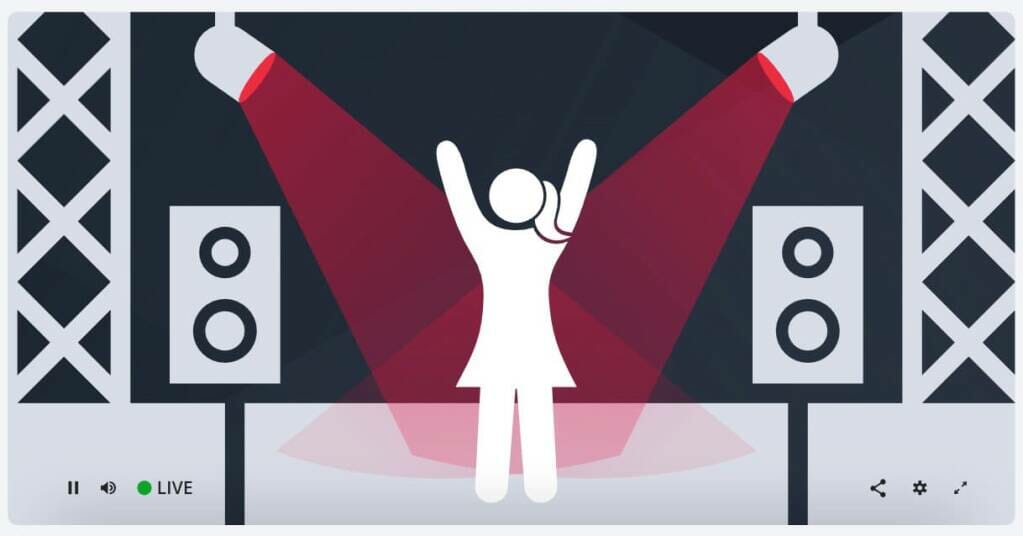

JW Player has been important and relevant since online streaming went mainstream.
JW Player originated as a video player that was leveraged by the YouTube founders back when YouTube was being developed. The company has since evolved to become a full-service streaming solution.
JW Player is great for audio streaming because it allows users to embed an audio-only MP3 player. This is different from many of the solutions we’ve described. The others are capable of audio-only streaming, but they use the standard video player with a static image.
In addition to its audio player support, JW Player is equipped with a wide range of useful streaming tools.
Key Features:
- Multi-bitrate and adaptive streaming
- Powerful content delivery
- Tech support
- Video API access on all plans
- Basic security features
- Monetization (only via advertising)
Pros:
- Reliable audio player
- User-friendly interface
- Customization capabilities
Cons:
- Limited access to live streaming support
- 12-hour limit on live audio streaming
- Limitations on tech support
- Limited to ad-based monetization
- No China video delivery
Pricing:
JW Player offers two main pricing plans. These are:
- 30-day free trial subscription which includes full API and SDK access, and a non-commercial license, with 25 GB hosting bandwidth and 75 GB streaming.
- Video Platform, which is available with custom pricing for high-volume storage and streaming. This plan supports Instant Live and Broadcast Live, while the trial subscription plan only supports VOD.
9. Panopto
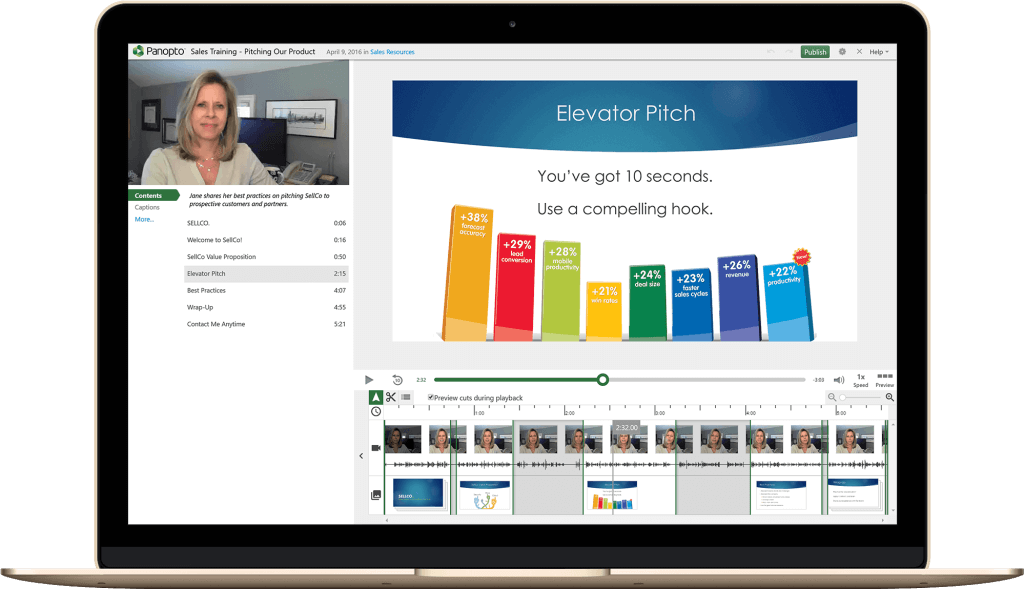

Panopto is designed for internal streaming.
Pantopto is a powerful streaming solution that is primarily used for internal streaming for educational purposes. It is used by schools to stream lectures and by businesses to stream training materials.
Panopto has special podcasting features that make it easy for educators to teach their students or trainees with audio content.
Key Features:
- Lecture-capture and video-search software
- Analytics access
- Privacy and security features
- White-label streaming
- API access for customization
Pros:
- Audio streaming support
- Document Indexing and full-text search
- Asset categorization for advanced organization
- Customizable branding
- China video hosting
Cons:
- No customizable templates
- Internal streaming only
Pricing:
Panopto recently ended support for Panopto Basic and Pro, which were previously part of its pricing packages. Currently, Panopto is only offering Panopto Enterprise, which comes with custom pricing. You may contact support to request for a demo.
10. Wowza
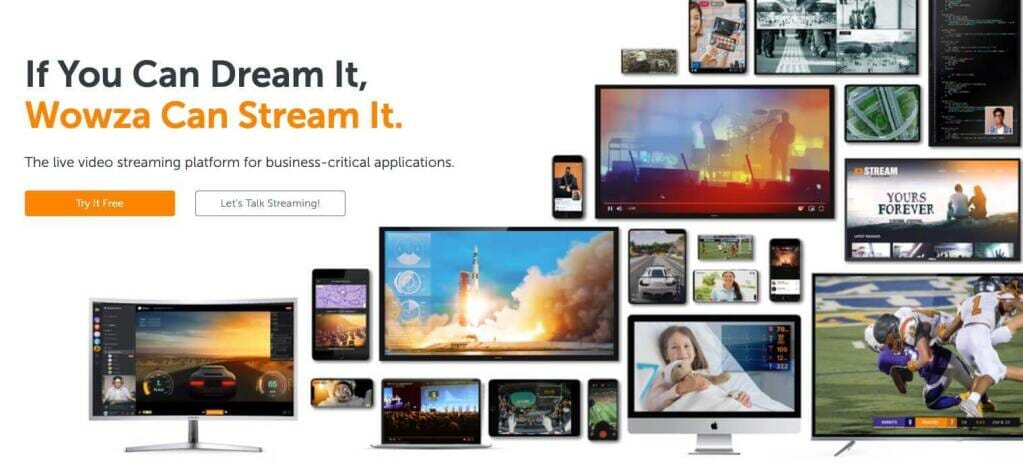

Wowza offers a couple of different streaming solutions.
Last but not least, Wowza is another excellent professional platform for hosting your audio streams. This solution includes API access, powerful security, cloud management, and more.
Wowza treats the files to broadcast audio-only similar to the files of an audio video broadcast. As mentioned, video and audio-only have many similarities when it comes to how they work. Another cool feature of Wowza is live audio stream recording. That means that you can capture your live audio stream so that your audience can play it back on-demand after the show has ended.
Key Features:
- Cloud management portal
- Wide range of security options
- API access for customization
- Live audio stream recording
Pros
- Reliable security
- Android and iOS Mobile apps streaming support
- Video streaming for video podcasts
- Video looping
- Robust HTML5 video player
- China video delivery
Cons:
- No video monetization tools
- Single-camera feed only
- No video analytics
- No event scheduling
Pricing:
Wowza Streaming Cloud offers 2 distinct pricing plans and services.
Wowza Video, which is an integrated video platform with API, has 3 pricing tiers comprising:
- One Month of Streaming: $149 (one-time purchase); includes 15 streaming hours and 500 viewing hours (pay-as-you-go overage options available), and pay for storage as needed
- Pay As You Go: $25/month; all usage billed separately
- Enterprise: Custom pricing; includes discounted rates on hours and storage, and 24/7 and real-time streaming at scale
The second service is Wowza Streaming Engine, which is on-premises software that comes with its own pricing plans comprising:
- One Month of Streaming: $295 (one-time and additional instance purchases); up to 10 concurrent, transcoded channels
- Basic Monthly: $195/month + $195/month for each additional instance; best for ongoing on-premise hosted streaming needs
- Enterprise: Please contact Wowza directly for access to their custom-tailored high volume enterprise solutions
Other Wowza services and support options include:
- Wowza CDN: Contact support
- Premium Support: Learn more
- Live Event Support: Contact support
Is a Live Video Streaming Solution Ideal for Audio Broadcasting?


Many online video platforms are suitable for broadcasting live audio.
When you’re looking for a podcast or radio station hosting service, it’s easy to think that an audio-specific solution is best. However, there are multiple reasons that may not be true.
A live video streaming solution is usually capable of audio-only streaming, and many organizations find that broadcasting live audio via a streaming solution is actually more suited to their needs.
Let’s look at a few reasons why this may be the case.
1. Live Broadcasting
Most podcast hosting services are made for hosting and delivering pre-recorded content that isn’t time-sensitive. This means that they aren’t well suited for live broadcasts that are scheduled or meant to be running 24/7.
In contrast, a live video streaming platform provides the functionality and power for live streaming, whether it is a scheduled event or a broadcast meant to run continuously around the clock. That includes distribution via a powerful live-streaming Content Delivery Network (CDN) for scaling to reach large, globally distributed audiences without buffering or lag problems.
Not every solution has this functionality, however, so make sure to do your research.
2. Audio File Storage and Hosting
Storage space is another of the largest differences. More storage allows you to store more podcasts and reuse them forever. One popular podcast hosting service costs $75 per month for 1.5 GB of monthly storage.
In comparison, Dacast offers 500 GB of storage for just $39 per month with an annual Starter plan. If you need more storage, you can upgrade to 2 TB for $165 per month.
Storage is important if you plan to publish a lot of podcasts or host many live audio streams. It’s also an important factor to consider if you want your podcast to go viral.
To give more context, 15 hours of audio amounts to about 1 GB of storage.
3. Monetization
Another major feature is monetization support. A live video streaming solution like Dacast provides an easy-to-use video paywall that is integrated into a white-label streaming player, offering pay-per-stream and subscriptions.
Streaming audio makes up an increasing proportion of music industry revenue. This is a substantial revenue stream that you can tap into via monetization tools. Some platforms even allow you to have your own store to sell merchandise.
Video hosting plans may also include some perks that podcast hosting and even the best music streaming services don’t include. These features range from analytics, API access, security and access control features, all the way to M3u8 playlist support, and more.
FAQs
1. What is meant by live audio streaming?
Live audio streaming is the real-time broadcast of audio content over the internet. It has gained popularity due to the rise of podcasts and music streaming services, offering a convenient way for businesses and individuals to reach a global audience.
2. What is the best live audio streaming platform?
Determining the best live audio streaming platform depends on your specific needs and preferences. Some top options include Dacast, Cincopa, and Wowza. Consider factors like features, pricing, ease of use, and scalability when choosing the platform that suits you best. Dacast offers robust tools at affordable pricing.
3. How do I set up an audio streaming service?
To begin live audio streaming, you need to make a plan, choose a live audio streaming platform, and embed your audio player into your website.
You should then get your podcast listed on platforms like iTunes, create your audio setup, test your setup, and finally, start streaming.
4. How do I host an audio stream?
You’ll need an encoder like Open Broadcaster Software (OBS) to capture your audio feed, streaming software like Dacast, and a hosting account. Connect your encoder to the software, configure your settings, and you can broadcast your audio live.
5. How do I get professional audio streaming quality?
Achieving professional audio quality for live streams involves several steps:
- Invest in a high-quality (XLR or USB) microphone and audio equipment.
- Ensure a quiet and acoustically treated recording environment to reduce background noise.
- Use dedicated audio streaming software for better control and customization.
- Opt for a reliable live audio streaming platform that supports high-quality audio.
- Set appropriate bitrates (at least 128kbps) and codecs for your audio streams.
- Fine-tune your audio in editing before streaming and make adjustments as needed to maintain quality.
Final Thoughts
More than one third of Americans listen to podcasts regularly. Millions more listen to online podcasts, paid and free music streaming services, and radio. With the growth of audio-only streaming only increasing, every business, organization or individual who wants to grow their brand should use it. Thankfully, as we’ve covered, getting started needs only a professional streaming platform and the right support.
If this sounds like you, try Dacast. Dacast is a professional live streaming platform used by successful professional businesses and organizations all over the world. With our 14-day risk-free trial, you can try all the features and talk to our support about how best to set up your audio streaming platform for success.
Do have questions or comments about our service for broadcasting live audio before giving Dacast a try? Let us know in the comment section below, and we’ll do our best to respond as soon as we can. For regular tips on live streaming and exclusive offers, we also invite you to join our LinkedIn group.
Thanks for reading, and good luck choosing the right streaming service for your radio broadcasts.


